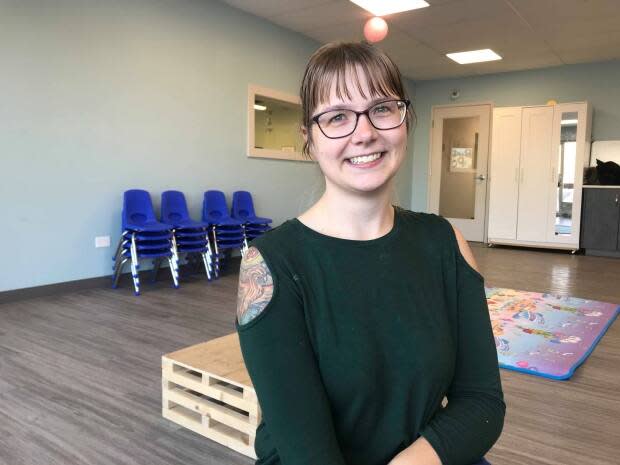Toddler ASL group fills a gap in Sask. deaf, hard of hearing community
Chloe Kalinowski is a force of nature. The toddler runs, spins, and chatters throughout her play session with a dozen other small children during her weekly play session in the Little Buttons program.
If she slows down long enough, you might catch a flash of pink or a little red blinker nestled between her ear and wispy blond hair. Chloe uses a hearing aid.
Saskatchewan is behind the times in terms of support for children like Chloe, according to the co-ordinators of the Little Buttons program. The Saskatoon class aims to build community and help kids with hearing impairments, along with their parents, develop communication skills — both through American Sign Language (ASL) and more general communication.
It's one of only two groups set up for toddlers with hearing impairments in the province, but parents have to seek it out themselves.
Run by the non-profit Saskatchewan Deaf and Hard of Hearing Services, the group receives very few referrals each year — not enough to create a community for these children and their parents.
Chloe's mom, Allison, follows along with the class, led by two women — both hearing impaired. The program is focused on children with hearing impairments, but Allison has brought Chloe's sister with her too — though Chloe is the only one in the family with hearing issues.
"We've been learning sign [language] as a family. It's just nice to find another group of people interested in learning the same," said Kalinowski.
The program, for infants and children up to the age of five, started last year. At the beginning of each eight-week seasonal session the children struggle, the co-ordinators say. They're shy and so are their parents. Learning a new language is daunting for the whole family.
An interpreter hangs back, surveying the room, jumping in when she sees a need. Anne Websdale helps the co-ordinators communicate with those who don't understand sign language. Like Chloe, her face lights up and she becomes animated as soon as she jumps in.
'You have to seek help out yourself'
There aren't very many role models for deaf or hard of hearing children. But Little Buttons co-ordinators Nicole Musey and Robyn Holmes step into the role easily and with enthusiasm.
They sign clearly, using both their hands and their faces. The children engage with the women, smiling and laughing, sometimes looking up shyly from under their long eyelashes.
They've become friends.

"I went to a camp every summer and met a lot of different deaf role models," said Musey, who is originally from northern British Columbia. She is profoundly deaf, meaning she can't hear at all.
"That's where I started learning language and met a lot of deaf kids my age."
But Musey says she really became the person — and role model — she is now at university, where everyone used ASL, including her teachers.
She gives a lot of advice to the parents she supports and teaches at Little Buttons. She mentions a grieving process parents often go through when they find out their child is deaf or hard of hearing, which comes along with anxiety and fear.
It's understandable, since parents aren't given any pamphlets or referrals to Saskatchewan's Deaf and Hard of Hearing Services, she says.

Allison Kalinowski says she and her partner were in the dark when they found out about Chloe's hearing impairment. They received medical direction and information about technology that would help Chloe hear a little better. But what about community?
"Mostly you have to seek the help out yourself," Kalinowski said. Without Little Buttons, the entire family would have more challenges communicating with Chloe, she says, and the program generally makes her daughter a lot happier.
Without it, she says, "I think there would be a lot of tantrums, with her personality."
Inspiring transformations
The first day of class can't even be compared to the last, says one of the group's co-ordinators.
"The kids were not really signing or participating, and as the weeks went by the kids started signing a little bit more, and then the parents were feeling a little bit more confident" in their own communication skills, said Holmes, who uses a combination of speech and ASL to connect with the people she supports.
With every class, the children have more fun, and their play circle tightens. Many of the children, like Chloe, run around a bit and come back to the circle for a few minutes of learning.
"It's just a really beautiful experience, to see something grow for them. And that's what our community here in Saskatoon really needs to grow."

ASL isn't front of mind for many people, according to Musey and Holmes.
To put language in the hands of people who struggle to communicate with those outside the deaf and hard of hearing community is to give them a better chance at connection.
The community is actually screaming for more materials, more networking connections. We're hungry for it. - Robyn Holmes, Little Buttons co-ordinator
Parents and siblings often learn ASL as a family, which improves everyone's lives, says Allison Kalinowski. Little Buttons has affected everyone in her family, not just Chloe. Her two other children are also totally committed to ASL, she says.
"They love learning sign with her. They like to communicate and sign, and they think it's funny that they can talk through windows or across rooms without yelling."
But that education and connection-building can't just fall on the shoulders of programs like Little Buttons, its co-ordinators say.
"The community is actually screaming for more materials, more networking connections. We're hungry for it," said Holmes.
Still, she and Musey aren't frustrated. How could they be, with all the little triumphs around them?
"It's given me a lot of inspiration."

